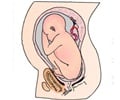A new study explains why allergies during pregnancy are linked to higher risks for attention-deficit hyperactivity disorder and autism in children.
Highlights
- Prenatal exposure to allergy affects the brain development and functioning of offspring.
- The number and behavior of immune cells in the developing brain of offspring were found to be altered.
- The offspring of allergic mothers were hyperactive, but had lower levels of anxiety-like behavior.
- Males born to the allergen-exposed mothers were more socially reserved compared to females.
Her team found significant changes in the brain make-up of fetuses and newborn rats exposed to allergens during pregnancy.
Animals that lived to adulthood after allergen exposure before birth showed signs of hyperactivity and antisocial behavior and decreased anxiety.
“This is evidence that prenatal exposure to allergens alters brain development and function and that could be an underappreciated factor in the development of neurodevelopmental disorders,” said Lenz, who presented the research in San Diego at Neuroscience 2016, the annual meeting of the Society for Neuroscience.
There are established links between allergies and attention-deficit hyperactivity disorder or ADHD and autism, as well as between inflammation and risk of autism, schizophrenia and ADHD.
“We’re really interested in figuring out unknown factors in psychological disorders and in differences between male and female brain development as it relates to autism, ADHD and other disorders,” Lenz said.
To study the effects of allergies on offspring, researchers sensitized female rats to ovalbumin (found in egg whites) before pregnancy.
The researchers exposed them to the allergen 15 days into their pregnancies, prompting an immune response in the animals.
They analyzed whether prenatal allergen exposure changed the number and behavior of immune cells in the developing brain of offspring.
They explored possible changes in young rats’ physical activity, anxiety-like behavior, ability to learn and sociability.
The researchers also examined the density of dendritic spines in the juvenile animals’ brains.
The spines protrude from neurons and are vital to cellular-level communication in the brain.
Post-Exposure Findings
Rats exposed to allergens before birth had higher levels of immune cells called mast cells in the brain and lower number of immune cells called microglia, regardless of the animals’ gender.
Rat offspring with allergic mothers were hyperactive, but had lower levels of anxiety-like behavior.
The mental flexibility of rats born to allergic mothers was also reduced.
Behavioral Differences in Male and Female Rat Offspring
When they interacted with other juvenile rats, the males in the allergen group were less likely to be violent with their peers.
“Young rats engage in social play and males are more rough and tumble and usually play much more than females,” Lenz said.
But the males born to the allergen-exposed mothers looked more like females.
They were more socially reserved and disengaged but really hyperactive. They displayed characteristics of ADHD.
The study shows that the dendritic spines – the points of synaptic connection between cells in the frontal cortex of the animals’ brains, were decreased in males with allergy exposure and increased in their female counterparts.
“They have to use rules to find a reward – a Cheerio in a terracotta pot – and the rules we give them keep shifting,” Lenz said, explaining that in one test the treat might be in a pot covered in sandpaper and in another test it might be in a pot covered in velvet.
The rats in the allergen group were not as capable of adapting to the changing parameters of the test, and the males had deficits that were more significant than the females.
Attention-Deficit Hyperactivity Disorder
ADHD is a brain disorder characterized by an ongoing pattern of hyperactivity-impulsivity and inattentiveness. It interferes with daily functioning and development.
Some patients with ADHD have issues with only one behavior while others have both hyperactivity-impulsivity and inattentiveness.
Among toddlers, hyperactivity is the most obvious symptom of ADHD.
In people with ADHD, the behavioral symptoms occur more often, with more severity and interferes with daily life activities and at social level.
A few risk factors that have been identified for ADHD are genes, alcohol use, cigarette smoking, exposure to pollutants during pregnancy and brain injury.
There is no cure for ADHD but the treatment includes a combination of medication, psychotherapy and training to control symptoms and improve the quality of life.
As of 2011, 11% or 6.4 million children between 4 to 17 years have been diagnosed with ADHD. The worldwide prevalence of ADHD among children and adolescents is between 5.29% and 7.1% and in adults it is at 3.4%.
Autism
Autism is one of the many disorders that falls under the autism spectrum disorder (ASD) group.
Though autism has its roots in very early brain development, the obvious symptoms occur between the ages of 2-3 years.
ASD is characterized by intellectual disability, poor attention, difficulty in motor coordination and physical symptoms like sleep and gastrointestinal disturbances.
According to the US Centers for Disease control and Prevention, one in 68 children in America fall under the autism spectrum. Prevalence of autism has increased from 10% to 17% in the recent years.
One in 42 boys and one in 189 girls are diagnosed with autism in the US.
Autism and ADHD are both three to four times as common in boys than in girls, Lenz said.
References
- Attention-deficit/hyperactivity disorder - (https://www.nimh.nih.gov/health/topics/attention-deficit-hyperactivity-disorder-adhd/index.shtml)
- Epidemiology - (http://www.adhd-institute.com/burden-of-adhd/epidemiology/)
- What is Autism - (https://www.autismspeaks.org/what-autism)
















